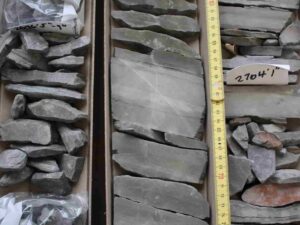
Massive volcanic events in Earth’s history that released large amounts of carbon into the atmosphere frequently correlate with periods of severe environmental change and mass extinctions. A new method to estimate how much and how rapidly carbon was released by the volcanoes could improve our understanding of the climate response, according to an international team led by researchers from Penn State and the University of Oxford.
The scientists reported this week (Feb. 26) in the journal Nature Geosciences that they have developed a new technique to estimate excess mercury left behind in the rock record due to ancient volcanic activity. The technique can estimate carbon emissions from large igneous provinces (LIPs), volcanic events that can last millions of years and produce magma that reaches Earth’s surface and forms lava flows hundreds of miles long.
“Large igneous provinces are often used as an analog for human-caused climate change because they occur relatively rapidly geologically and release a lot of carbon dioxide,” said Isabel Fendley, assistant research professor of geosciences at Penn State and lead author of the study. “But one big challenge we address with this study is that to date, it has been really difficult to figure out exactly how much carbon was released by these volcanoes.”
The researchers analyzed core samples that capture a 20-million-year record of the early Jurassic period and found mercury levels increased during the peak activity of the Karoo-Ferrar large igneous province and the associated Toarcian Oceanic Anoxic Event, a period of extensive environmental and climate change some 185 million years ago.
However, the total estimated carbon emissions using the mercury records were significantly lower than what carbon-cycle models had predicted would be necessary to cause the observed environmental changes.
The findings suggest the volcanism triggered positive Earth system feedbacks — climate and environmental responses to the initial warming that in turn produced more warming. These positive feedbacks may be as important as the primary emissions in these large carbon emission scenarios, and current carbon cycle models may be underestimating the effects of a given amount of emissions, the scientists said.
‘What this shows us is that there are Earth system responses that exacerbate the effects of the carbon the volcanoes emitted,” Fendley said. “And based on our results, these feedback processes are actually quite important but not well understood.”
Accurate estimates of LIP carbon emissions are important for understanding the impacts of positive and negative carbon-cycle feedback processes on future climate projections, the scientists said.
“In addition to historical climate change and understanding the history of life, it’s also relevant for how we understand Earth’s climate and how we investigate what happens to the environment after you release large amounts of carbon dioxide into the atmosphere,” Fendley said.
Estimating the quantity of carbon emissions associated with LIPs has been a challenge in part because scientists have an incomplete record of how much lava erupted. The Karoo-Ferrar LIP, for example, occurred on the former supercontinent Gondwana, and that material is now spread out across the southern hemisphere, spanning modern-day Southern Africa, Antarctica and Tasmania, the scientists said.
The researchers instead turned to mercury, which is released as a gas during volcanic eruptions but was otherwise rarely found in high concentrations in the environment prior to human activity. Looking at the chemistry of rocks in the core samples, the scientists were able to determine how much mercury would be expected based on environmental conditions and how much extra was present caused by the volcanoes.
They developed a method to convert the measured changes in mercury concentrations to the volume of mercury gas emissions. Using the ratio of mercury gas emissions to carbon emissions in modern volcanoes, they estimated how much carbon the ancient volcanoes released.
The researchers said the core samples, from the Mochras borehole in Wales, U.K., provided a unique opportunity to conduct this research. The long record showed the first clear evidence that there were significantly larger volcanic eruptions during this time period compared to the preceding 15 million years, the scientists said.
“The large amount of existing geochemical data from the Mochras Farm (Llanbedr) borehole in Wales, drilled by the British Geological Survey, plus the very well-constrained chronology, provided a unique opportunity that enabled this analysis,” Fendley said. “The decades-worth of previous work on the Mochras core enabled us to reconstruct original gas fluxes over millions of years, for periods that are traditional targets for paleo-environmental studies as well as the background state.”
Other researchers on this project were Joost Frieling, postdoctoral research assistant, and Tamsin Mather and Hugh Jenkyns, professors, at the University of Oxford; Michael Ruhl, assistant professor at Trinity College Dublin; and Stephen Hesselbo, professor at the University of Exeter.
European Research Council and the Natural Environment Research Council provided funding for this work.
Reference:
Isabel M. Fendley, Joost Frieling, Tamsin A. Mather, Micha Ruhl, Stephen P. Hesselbo, Hugh C. Jenkyns. Early Jurassic large igneous province carbon emissions constrained by sedimentary mercury. Nature Geoscience, 2024; DOI: 10.1038/s41561-024-01378-5
Note: The above post is reprinted from materials provided by Penn State. Original written by Matthew Carroll.









